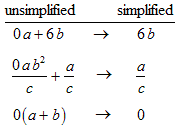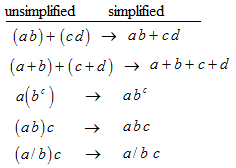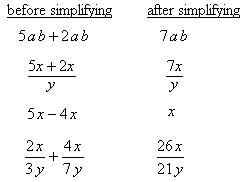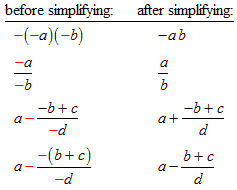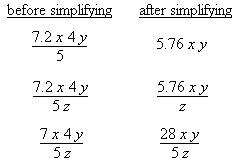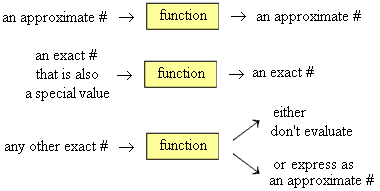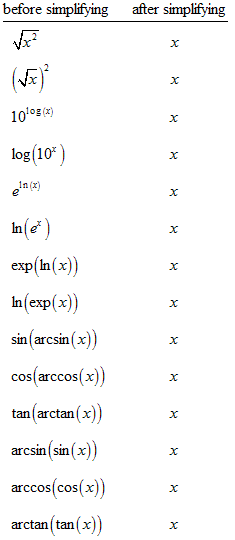3.8 - Reference - Simplifying Expressions
Before you start working on an expression (say factoring it, distributing it, or combining it with some other expression) that expression should be in the simplest form possible. Otherwise you are making your life harder than it has to be. Similarly after you have finished working on an expression you should always leave it in simplest form. The person who has to look at your results will appreciate it!In this section we first explain the two possible types of simplifications that can be applied to an expression: exact simplifications and floating point simplifications.
Then we give an exhaustive list of possible simplifications ranging from the most basic that you will apply all the time to the most complex that you may never encounter.
Just as you should do, the Algebra Coach program always returns its results in simplest form. You can type an unsimplified expression into the Algebra Coach’s listbox and get it put into simplest form by clicking the Simplify button.
Exact simplifications vs. floating point simplifications
Consider these numbers: the fraction 2/3, the radical and
the special numbers e and
π.
Each of these numbers has a precise meaning and
when written in the form just shown, they are considered to be exact.
On the other hand, writing them like this: 0.667, 1.73, 2.7 and 3.14, is just an
approximation. This form is called the floating point form of these numbers.
(Floating point means that the number is written with a decimal point and
there can be any number of digits before and after the decimal point.)
and
the special numbers e and
π.
Each of these numbers has a precise meaning and
when written in the form just shown, they are considered to be exact.
On the other hand, writing them like this: 0.667, 1.73, 2.7 and 3.14, is just an
approximation. This form is called the floating point form of these numbers.
(Floating point means that the number is written with a decimal point and
there can be any number of digits before and after the decimal point.)In general all integers, fractions, radicals and the numbers e and π are considered to be exact numbers and all numbers written in floating point form (i.e. with a decimal point) are considered to be approximate numbers.
An expression containing only exact numbers can actually be simplified in two different ways:
- to a result that is also expressed in exact form, or
- rounded to a result expressed in floating point form.
Thus before you begin simplifying an exact expression you should decide if you want a result expressed in exact or floating point form. In pure math calculations an exact result is preferred and in engineering work a floating point result is preferred.
The Algebra Coach has an option that you can set to keep exact expressions exact when simplifying or to express them using floating point numbers. This option does not affect expressions containing floating point numbers; they are always simplified using floating point numbers.
Example: Consider the expression
 .
It is the sum of two fractions which are considered to be exact, and so the whole expression
is also exact. It can be simplified to exact form using fraction addition like this:
.
It is the sum of two fractions which are considered to be exact, and so the whole expression
is also exact. It can be simplified to exact form using fraction addition like this:
or the fractions can be converted to floating point form and then added like this:
Example: Consider the expression
 .
It is a floating point expression because it contains a floating point number.
It can only be simplified to floating point form, like this:
.
It is a floating point expression because it contains a floating point number.
It can only be simplified to floating point form, like this:
Here is a checklist of various simplifications that you can apply to an expression. We have organized them into categories:
Housekeeping or good style simplifications
- sort the terms of an expression from highest degree to lowest
- sort the factors of a term into alphabetical, coefficient-first order
- drop zero terms, unnecessary + signs and unnecessary factors of 1
- drop unnecessary brackets
- distribute + and − signs
- add like terms
- combine several signs of factors into a single sign
- combine several numerical factors into a single factor
- combine exponential factors with the same base using the properties of exponents
- evaluate exponentials
- evaluate functions
- be aware of alternative notations used for square roots, exponential functions and reciprocals
- simplify a fraction multiplied or divided by a non-fraction
- replace the product of two fractions by a single fraction
- replace the quotient of two fractions by a single fraction
- reduce common fractions, fraction coefficients and algebraic fractions to lowest terms
- simplify exponentials with bases or exponents of 0 or 1
- simplify exponentials with negative exponents
- simplify exponentials whose bases are exponentials
- simplify exponentials whose bases are products or quotients
- simplify exponentials whose exponents are fractions
- use the fact that

- simplify the square root of a perfect square
- simplifications involving the square roots of integers
- simplification of square roots involving fractions
- simplify the logarithm of an exponential
- simplify the logarithm of a reciprocal
- simplify the ratio of two logarithms of numbers
- cancel a function composed with its inverse function
- simplify certain trigonometric function compositions
- simplify by eliminating csc, sec and cot in favor of sin, cos and tan
- simplify by eliminating negative arguments of sin, cos and tan
- simplify sin, cos and tan by removing π/2 or 90° phase shifts
- simplify using Pythagoras’ theorem
- express the square roots of negative numbers as imaginary numbers
- evaluate the sum, difference, product or quotient of two complex numbers
- use Euler’s formula to convert complex numbers between polar and rectangular coordinates
- evaluate functions whose input or output are complex numbers
Housekeeping or good style simplifications
Simplify by sorting the terms of an expression from highest degree to lowest
If an expression is a sum of terms then it is customary to sort the terms from highest degree to lowest. For example the polynomial on the left should be simplified to the one on the right:
Simplify by sorting the factors of a term into alphabetical, coefficient-first order
If an expression is a product of factors (i.e. a single term or monomial) then it is customary to write it with one single number in front (called the coefficient) followed by the rest of the expression with any letters (called literals) in alphabetical order. For example the expression on the left should be simplified to the one on the right:Furthermore, if an expression is an algebraic fraction and the numerator and the denominator are products of factors then the above sorting convention applies to the numerator and to the denominator. For example the expression on the left should be simplified to the one on the right:

Simplify by dropping zero terms, unnecessary + signs and unnecessary factors of 1
Zero times anything is zero. Thus if a term in an expression has a factor of zero then that term is zero. Since zero is the additive identity a zero term can and should be dropped. Some examples are:A factor of 1 in a term does not have to be written since 1 is the multiplicative identity. Also a + sign in front of a single term or in front of the first term of a sum of terms is understood and does not have to be written. Thus these simplifications should be made:
The only exception is when the 1 is used as a placeholder as in this example (otherwise the numerator would be blank):
so no simplification is possible.

Simplify by dropping unnecessary brackets
The acronym BEDMAS (Brackets, Exponents, Division and Multiplication, Addition and Subtraction) refers to the order of operations within an expression. Brackets are at the top of the list and their purpose is to move part of an expression to the top of the list.Now, if part of an expression is already at the top of the list then putting brackets around it is unnecessary and those brackets should be omitted. Some examples are:
Note:
- Be aware that in the last example c is in the numerator, not the denominator.
Since many people might be confused by this it might be a good idea to leave the brackets in,
or even better, to write the fraction as
 .
.
- In some cases brackets do not appear in the typeset form but they are
necessary when typing in the expression.
They are deemed to be in certain locations such as the exponent and the
numerator above and the denominator below a horizontal division line.
For example:
Click here for more information on invisible brackets.

Basic simplifications
Simplify by distributing + and − signs
The distributive law states that:a (b + c) = a · b + a · cThe quantity a can be a + or a − sign in which case you are distributing a 1 or a −1. Be aware that:
- adding a negative is the same thing as subtracting
(see the second and third examples below),
- when distributing a − sign over a sum you must flip the sign of each term of the sum (see the last two examples below).
before simplifying after simplifying a + b + (c + d) a + b + c + d a + (−b) a − b (a − b) + (−c + d) a − b − c + d a − (−b + c) a + b − c − (−b + c) b − c

Simplify by adding like terms
Add like terms by adding their coefficients. Here are some examples:Click here for details on adding like terms and more examples.
Note:
- In the second example the like terms happen to be in the numerator of the fraction.
- In the third example we are subtracting instead of adding like terms and we write the result as x instead of 1 x.
- In the last example the coefficients happen to be fractions
and
 .
Click here to see how to add common fractions.
.
Click here to see how to add common fractions.

Simplify by combining several signs of factors into a single sign
If a term in an expression has several negative factors (in either the numerator or denominator) then count how many there are. If there are an odd number then the term is negative and we should replace all the − signs by a single − sign. If there are an even number then the term is positive. Click here for more information. Here are some examples:
Simplify by combining several numerical factors into a single factor
If a product or quotient contains several numerical factors then they should be combined into a single number called the coefficient. The coefficient could be any kind of number including a fraction. Here are some examples:Note:
- The first and second examples both contain the floating point number, 7.2, so all the numbers are combined into the single floating point number, 5.76.
- The second example results in an algebraic fraction. The coefficient, 5.76, is put in the numerator (or possibly in front of the fraction).
- In the third example the numbers 7, 4 and 5 are all considered to be exact so the resulting coefficient is kept exact and written as the fraction 28/5.

Simplify by combining exponential factors with the same base using the properties of exponents
If an expression has several exponential factors with the same base (in either the numerator or denominator) then they should be combined using the properties of exponents. Here are some examples:
Simplify by evaluating exponentials
If both the base and exponent of an exponential are numbers then we should simplify by evaluating the exponential. In this example the exponential 2 4 is evaluated:Evaluating an exponential is often considered to be a function called the power function.

Simplify by evaluating functions
If the argument of a function is an approximate or floating point number then the value of the function is also a floating point number and we should simplify by evaluating the function.If the argument of the function is an exact number then the value of the function is also an exact number. However only a few exact arguments have known, simple exact function values. These function values are called special values. (For example click here to see special values for the sin, cos and tan functions.) For all other exact arguments the exact function values are not known or are so complicated as to be useless. Thus we can either leave them unevaluated or round them off and give approximate values. These three cases are summarized in this picture:
Here is an example of each of these cases:
Click for more information on functions in general and the eleven built-in functions of the Algebra Coach.

Be aware of alternative notations used for square roots, exponential functions and reciprocals
Be aware that the square root of x can be written in two ways: using radical notation and using exponential notation. Radical notation is the standard:Here is an example of a simplification where the exponential notation for the square root is useful:
The exponential function can be written two ways: using exponential notation and using function notation. Exponential notation is the standard:
Reciprocals can be written in two ways: using fraction notation and using exponential notation. Fractional notation is the standard:
Among other things, exponential notation for reciprocals is useful for seeing the connection between factoring and finding common denominators.

Simplifications involving fractions
Simplify a fraction multiplied or divided by a non-fraction
A fraction multiplied by a non-fraction should be replaced by a single fraction, like this:In words, the non-fraction becomes a factor in the new numerator. This is just a special case of multiplying two fractions. Here’s why:
Similarly, a fraction divided by a non-fraction should be replaced by a single fraction, like this:
In words, the non-fraction becomes a factor in the new denominator. This is just a special case of dividing two fractions. Here’s why:

Simplify by replacing the product of two fractions by a single fraction
The product of two fractions can be simplified by replacing it by a single fraction, like this:In words, the two fractions a/c and b/d multiply to give a new fraction whose numerator is ab and whose denominator is cd. Click for more information on multiplying common fractions and multiplying algebraic fractions. Here is an example:
This simplification is really an example of the associative law of multiplication, which states that it doesn’t matter in what order we multiply and divide the factors. This simplification has all kinds of consequences:
- It shows that the following forms are all equivalent.
Notice that in all cases a and c are in the numerator
and b is in the denominator. The Algebra Coach simplifies all
the other forms to the last form:

- It shows that multiplying by the reciprocal of b is the same
as dividing by b:

- By factoring the numerator and denominator and then reversing this simplification
we can reduce a fraction to its simplest equivalent fraction.
Here is an example:


Simplify by replacing the quotient of two fractions by a single fraction
The quotient of two fractions can be simplified by replacing it by a single fraction, like this:In words, the division of the fraction c/d by the fraction b/a is replaced by the multiplication of the fraction c/d by the reciprocal a/b. Then this multiplication of two fractions is carried out as described above. Click for more information on dividing common fractions and dividing algebraic fractions. Here is an example:
Here is another example:
This is a very useful result: The result of dividing two fractions with equal denominators is a fraction consisting of just the two numerators.
Here is another useful example: a non-fraction divided by a fraction. Notice how the fraction (because it comes from the denominator) is inverted:

Simplify by reducing common fractions, fraction coefficients and algebraic fractions to lowest terms
Any fraction should be reduced to lowest terms or to its simplest equivalent fraction. This is done by factoring the numerator and denominator of the fraction completely and looking for cancellations. There are three places to look for cancellations.- In a common fraction. Here is an example:

- In a coefficient that is a fraction. Here is an example:

- In an algebraic fraction. Here is an example:


Simplifications involving exponentials
Simplify exponentials with bases or exponents of 0 or 1
Any exponential with base or exponent equal to 0 or 1 should be simplified as shown in this list:- Anything raised to the power 0 equals 1.
Click here for more information.
b 0 = 1
- Any “thing” raised to the power 1 just equals the “thing”:
b 1 = b
- 1 raised to any power equals 1.
1 x = 1
- 0 raised to a power can equal 0, 1 or be undefined. Click here for more information.

Simplify exponentials with negative exponents
One of the properties of exponents is that:In other words any quantity raised to the power −1 is just the reciprocal of that quantity. The fraction form, 1/b, on the right side of this property is usually considered to be the simpler form but the exponential form, b−1, on the left is useful for seeing, for example, the connection between factoring and finding common denominators.
The above formula can be generalized to any negative exponent:
Here are some examples:
Click here for more information and examples.

Simplify exponentials whose bases are exponentials
The exponentiation property of exponents states that:This property is used to replace the complicated exponential on the left side by the simpler exponential on the right side. Here are some examples:
Note: The last example shows that raising a quantity to the 1/3 power is the same as taking the cube root of that quantity.

Simplify exponentials whose bases are products or quotients
If a product or quotient is raised to some power then each factor of the product or quotient can be separately raised to that power. Here is some examples:Note that this simplification applies only to products or quotients. It does NOT apply to sums or differences! Click here for more information and examples.

Simplify exponentials whose exponents are fractions
Using the exponentiation property of exponents we can write b m/n two ways:In words, b m/n may be thought of as the nth root of the mth power of b or as the mth power of the nth root of b.
Here is an example that makes use of this simplification:
Click here for more information.

Simplifications involving square roots (radicals)
Simplify using the fact that 
Recognizing that radicals can be expressed in
exponential form,  , and then using the
properties of exponentials,
allows us to make various simplifications involving radicals, such as:
, and then using the
properties of exponentials,
allows us to make various simplifications involving radicals, such as:
 Click here for more information.
Click here for more information.



 Click here for more information.
Click here for more information.

Simplify the square root of a perfect square
If the radicand (the quantity under the square root) is a perfect square then write it in factored form and cancel the square and the square root. Here are two examples:
Simplifications involving the square roots of integers
- If the radicand (the quantity under the square root) contains a perfect square factor then
remove the factor from the radicand.
Here is an example:

- Sometimes replacing the product of square roots of integers
by the square root of a product will result in a perfect square factor which can then
be removed as described in the first bullet. Click here for more information.
Here is an example:


Simplification of square roots involving fractions
An expression is considered to be simpler when there are no radicals in the denominator. The process of removing them is called rationalizing the denominator. There are three ways to achieve this.- Suppose that the denominator of a fraction contains a square root.
Then multiply both the numerator and denominator of the fraction by
that square root and simplify. This will eliminate the radical from the denominator.
Here is an example:

- Suppose that a square root contains a fraction.
Then multiply both the numerator and denominator of the fraction by the denominator of
the fraction and simplify. This will eliminate the radical from the denominator.
Here is an example:

- Suppose that the denominator of a fraction is a binomial, a + b,
and that one or both of the terms is a radical. Then multiplying the numerator and
denominator of the fraction by the binomial conjugate, a − b, of the denominator and distributing
will eliminate all radicals from the denominator.
Click here for more information.
Here is an example:


Simplifications involving logarithms
Simplify the logarithm of an exponential
The logarithm of an exponential property of logarithms states that:You can use this property to simplify and replace the expression on the left by the one on the right. The right side is considered to be simpler than the left side because an exponentiation on the left side is replaced by a multiplication on the right side. Here are two examples:
(The second example first used the logarithm of a product property.)

Simplify the logarithm of a reciprocal
The logarithm of a reciprocal property of logarithms states that:You can use this property to simplify and replace the expression on the left by the one on the right. The right side is considered to be simpler than the left side because a reciprocal on the left side is replaced by a negative on the right side. Here is an example:

Simplify the ratio of two logarithms of numbers
Sometimes the ratio of the logarithms of two numbers, ,
can be simplified. This happens when the two numbers happen to have the same base, say n,
raised to two different powers, say a and b. Then the ratio simplifies like this:
,
can be simplified. This happens when the two numbers happen to have the same base, say n,
raised to two different powers, say a and b. Then the ratio simplifies like this:
Example: The exponential equation 4 x = 128 can be solved for x by taking the logarithm of both sides, then using the logarithm of an exponential property on the left side and then solving for x. The result is this ratio of two logarithms of numbers:
This can be simplified further if we recognize that 128 and 4 are both 2 raised to different powers:

Simplifications involving function compositions
Simplify by canceling a function composed with its inverse function
Certain functions are inverses of each other and cancel when composed. For any x, the following compositions can be simplified. (Click on any entry in the table for more information):These inverse function compositions often occur when we solve an equation by doing the same thing to both sides of the equation. For example the equation:
10 x = 33can be solved for x by taking the (base 10) logarithm of both sides, like this:
log (10 x ) = log (33)According to the fourth row in the above table the left side of the equation then simplifies like this:
x = log (33)and the right side can then be evaluated.

Simplify certain trigonometric function compositions
Certain compositions of trigonometric functions don’t cancel but they do simplify, like this:To derive the simplifications, refer to the triangles. For example the first triangle has been set up so that θ = arctan(x). Pythagoras’ theorem then gives the length of the third side. The first two simplifications result from getting the values of sin(θ) and cos(θ) for that triangle. The other simplifications are derived the same way.
These function compositions often occur when we solve an equation by doing the same thing to both
sides of the equation. For example suppose that in the triangle shown to the right we want to find the tangent of the angle
θ without actually finding θ.
This can be done by noticing that
θ = arcsin (0.4)and taking the tangent of both sides of this equation. This gives: tan (θ) = tan (arcsin (0.4)) |
 |
and it can now be evaluated.
The following compositions of trig functions also simplify:
arccos(sin(θ)),They all simplify to π/2 radians − θ (or to 90° − θ in degree mode). To prove this notice that these 4 statements apply to the triangle shown:
arcsin(cos(θ)),
arctan(1/tan(θ)).
Now simply apply the operations indicated by the arrows:

Simplifications involving trigonometric expressions
Simplify by eliminating csc, sec and cot in favor of sin, cos and tan
The reciprocal identities can be used to eliminate the cot, sec and csc functions in favor of the sin, cos and tan functions. Here are the identities:
Simplify by eliminating negative arguments of sin, cos and tan
A negative angle inside a sin, cos or tan function can be eliminated in favor of a positive angle using the negative angle identities:sin(−θ) = −sin(θ)
cos(−θ) = cos(θ)
tan(−θ) = −tan(θ)

Simplify sin, cos and tan by removing π/2 or 90° phase shifts
The “ left shift by 90° ” identities are:- sin(x +
π/2)
= cos(x) or
sin(x + 90°) = cos(x)
- cos(x +
π/2)
= −sin(x) or
cos(x + 90°) = −sin(x))
- tan(x + π/2) = −1/tan(x) or tan(x + 90°) = −1/tan(x)
sin(x + 270°) = cos(x + 180°) = −sin(x + 90°) = −cos(x).These identities are an important part of the algorithms used by the Algebra Coach and by calculators and computers to evaluate the sin, cos, and tan functions.

Simplify using Pythagoras’ theorem
Pythagoras’ theorem states that sin2(θ) + cos2(θ) = 1. In each of the following expressions the left-hand-side can be replaced by the right-hand-side, which is considered to be simpler because it contains only one term:sin2(θ) + cos2(θ) = 1
1 − sin2(θ) = cos2(θ)
1 − cos2(θ) = sin2(θ)

Simplifications involving complex numbers
Express the square roots of negative numbers as imaginary numbers
An imaginary number is the square root of a negative number. The imaginary unit i is defined as:The square root of any negative number can be simplified by expressing it as a multiple of the imaginary unit i. Here are two examples:
In engineering fields where the symbol i already represents the electric current, the symbol j is often used to denote the imaginary unit.

Evaluate the sum, difference, product or quotient of two complex numbers
Click here to see examples of arithmetic with complex numbers.
Use Euler’s formula to convert complex numbers between polar and rectangular coordinates
Complex numbers often have to be converted back and forth between polar, rectangular and exponential forms. Euler’s formula is used to make the conversion. It states thatClick here for more information.
An important special case is Euler’s identity,
e i π = −1.Click here for more information.






